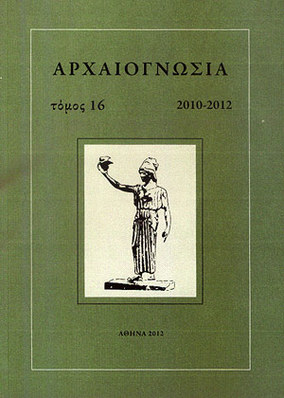Ερυθρόμορφο κάλυμμα λεκανίδας της τεχνοτροπίας του ζωγράφου του Μειδία
Part of : Αρχαιογνωσία ; Vol.15, No.1-3, 2007, pages 189-227
Issue:
Pages:
189-227
Parallel Title:
A red figure lekane lid in the manner of the Meidias painter
Section Title:
Μελέτες - Articles
Abstract:
The lid, inv. no. A 21143 came to light in 2006 during an excavation conducted by the 3d Ephorate of Prehistoric and Classical Antiquities, near Larissa Station in Athens. The Attic red figure lid can be dated to the last decade of the 5th century BC on external and mainly on internal evidence. In my opinion the iconographical theme and style must be in the manner of the Meidias Painter, as argument on several issues leads us, and also if we concentrate especially on the female figures that follow the master’s repertoire of standing, reclining and self-admiring females. Most probably the vase painter has chosen to depict two episodes of Dionysus’ life: his marriage to Ariadne after her abandonment by Theseus on the island of Naxos and the god’s ceremonial union with Basilinna (the wife of Archon-Basileus) during the second day (Chocs) of the Anthesteria festival in Athens. Far from attempting a faithful rendering o f the nuptial ceremony, the painter implicitlychooses a number of symbolic and emblematic motifs and stances that allege to a divine union. The scene is idealized and set apart from real time-scale and context, with the exception of the female box-carrier and her follower, who point to the custom of “epavlia" (“έπαύλια”) taking place on the second day of he Athenian wedding. On the scene of our lid A 21143 gods coexist with the mortals, mythical context with cult and life after death with real life.
Subject:
Subject (LC):
Keywords:
Μειδίας
Notes:
Για την άδεια δημοσίευσης του καλύμματος της λεκανίδας A 21143 ευχαριστώ την Έφορο της Γ' EI IKA κ. Ν. Διβάρη-Βαλάκου και την αρχαιολόγο κ. Ό . Ζαχαριάδου, η οποία είχε τη γενική εποπτεία του συγκεκριμένου ανασκαφικού τομέα από τον οποίο προέρχεται το εύρημα. Επίσης, ευχαριστώ την Καθηγήτρια κ. E. Παπουτσάκη-Σερμπέτη για τις εύστοχες παρατηρήσεις της, τον αρχαιολόγο κ. Λ. Μπουρνιά, ο οποίος μου υπέδειξε το αντικείμενο προς μελέτη, ετοίμασε το ανάπτυγμα και προσέφερε σημαντικές παρατηρήσεις, καθώς και τον αρχιτεχνίτη της ανασκαφής κ. Γεώργιο Τσιτωνάκη. Τέλος, θέλω να ευχαριστήσω την καθηγήτρια κ. Λ. Λαιμού όχι μόνο για τις πολύτιμες παρατηρήσεις της για το συγκεκριμένο άρθρο, αλλά και για τη βοήθεια, τη συμπαράσταση και τις ανεκτίμητες συμβουλές της σε επιστημονικό επίπεδο, όλα αυτά τα χρόνια που είναι καθηγήτρια μου. Η φωτογράφηση του αντικειμένου A 21143 έγινε από τη γράφουσα.




